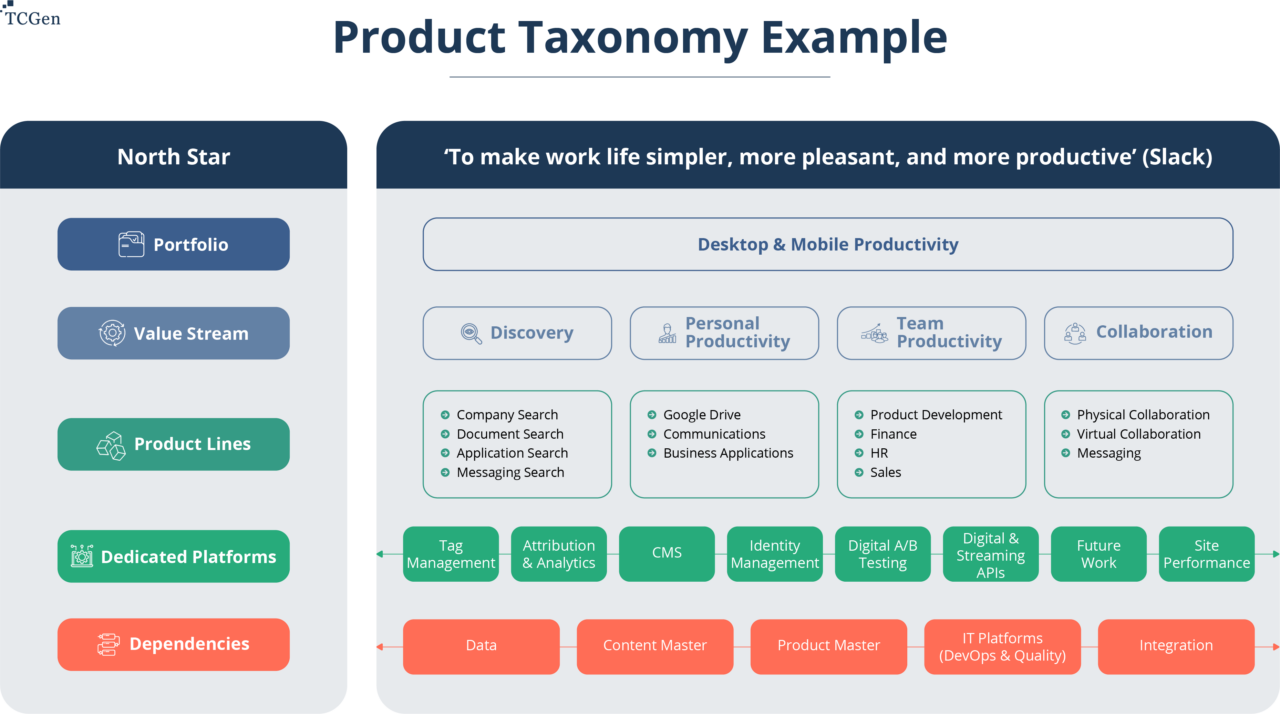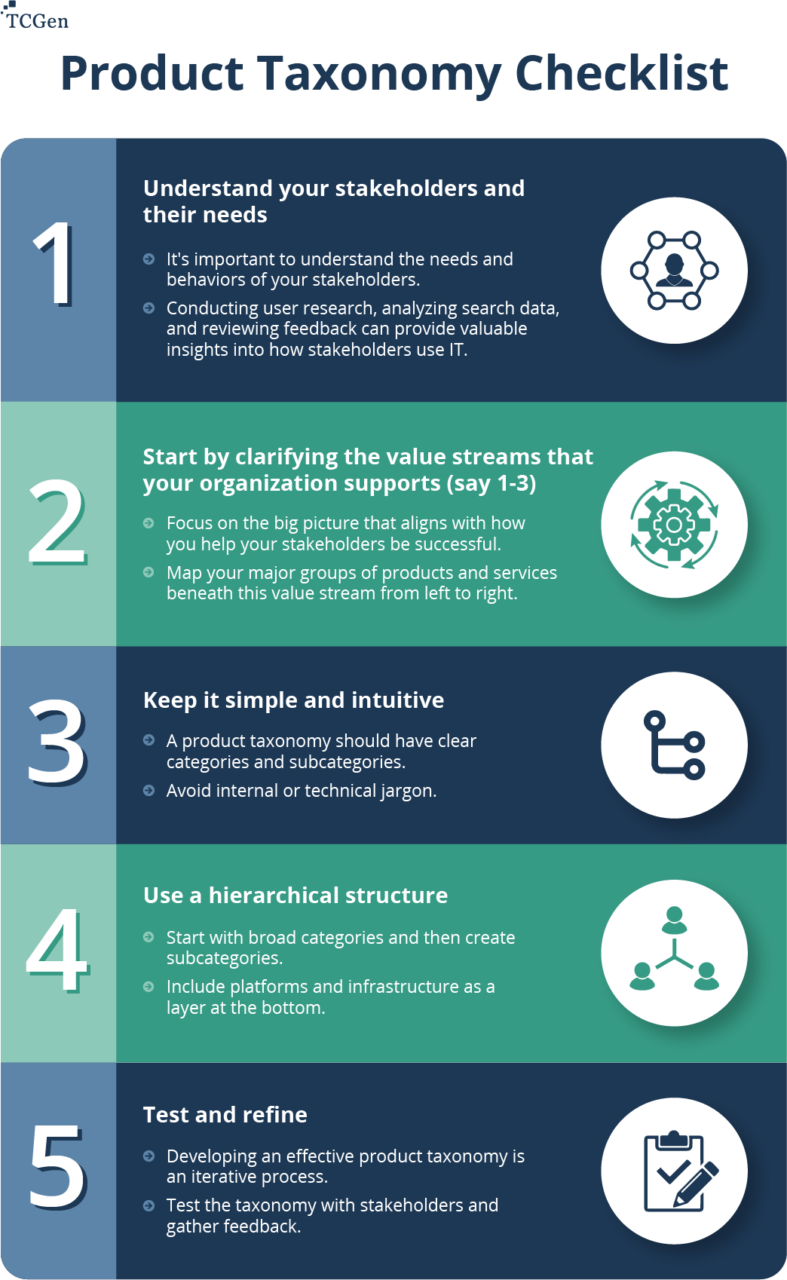What is a product taxonomy?
A product taxonomy is a systematic categorization of products based on their attributes, characteristics, and relationships to other products. Usually, it is a tool for retailers, ecommerce businesses, and manufacturers who need to organize their product data to improve their online search and navigation experience, as well as to better understand their product portfolio.
While its use in eCommerce is well-known, it is also essential in IT, where managers want to align their product management accountabilities with product lines and teams need to satisfy many different stakeholders.
In this article, we will discuss what product taxonomy is, its benefits, how it can help IT organizations, and how to create an effective taxonomy for your business.

How to use a product taxonomy in IT organizations
A product taxonomy used by IT organizations is a hierarchical classification system that categorizes and organizes products, services, and solutions offered by the IT department within a company. A taxonomy helps streamline communications, and assists in decision-making and in resource allocation. It provides a structured framework for understanding and managing the IT portfolio.
Key components of a product taxonomy for internal IT organizations typically include:
Levels: The taxonomy is organized into multiple levels, with each level representing a degree of specificity. Common levels include categories, sub-categories, and individual products or services.
Categories: Broad groupings of IT products, services, or solutions based on their primary functions or objectives. Examples of categories might include infrastructure, applications, security, or data management.
Sub-categories: More specific classifications within each category that further refine and differentiate between products or services. For instance, within the applications category, there could be sub-categories like enterprise resource planning (ERP), customer relationship management (CRM), or human resources management systems (HRMS).
Products/Services: The individual items, tools, or solutions that are offered by the IT organization. These are typically grouped under the relevant sub-categories and can include software, hardware, or support services.
Attributes: Descriptive information that provides additional context or detail about each product or service, such as vendor, version, licensing model, or integration requirements.
Benefits of a Product Taxonomy for IT
Product taxonomies can be valuable tools for IT organizations to enhance stakeholder value. Here are some ways in which IT organizations can utilize product taxonomies to focus on stakeholder value:
- Clear Communication: Product taxonomies provide a common language and structure for classifying and organizing IT products and services. By establishing a standardized taxonomy, IT organizations can effectively communicate with stakeholders, ensuring a shared understanding of products and their functionalities. This clarity helps stakeholders make informed decisions that align with their specific needs and objectives.
- Alignment with Business Goals: A well-designed product taxonomy can align IT offerings with the overall business goals and objectives of an organization. By categorizing products and services based on business functions or strategic priorities, IT organizations can prioritize their efforts and investments to deliver value in line with stakeholder expectations. This alignment enhances the relevance and impact of IT solutions, thereby increasing stakeholder satisfaction.
- Tailored Service Delivery: Product taxonomies can enable IT organizations to develop targeted service catalogs and offerings that address the diverse needs of stakeholders. By segmenting products and services into specific categories, IT teams can customize their offerings to different stakeholder groups, ensuring that each group receives the most relevant and value-added IT solutions. This personalized approach enhances stakeholder experience and satisfaction.
- Resource Optimization: Effective product taxonomies help IT organizations understand the demand for various products and services. By analyzing usage patterns and stakeholder requirements within each category, IT teams can optimize resource allocation and investment decisions. This optimization ensures that resources are allocated where they are most needed, leading to increased stakeholder value through improved efficiency and cost-effectiveness.
- Future Planning: Product taxonomies provide a foundation for IT organizations to anticipate future needs and trends. By analyzing the taxonomy structure and identifying emerging technologies or evolving stakeholder requirements, IT teams can proactively plan for future product and service offerings. This foresight enables organizations to stay ahead of the curve, deliver innovative solutions, and maintain stakeholder satisfaction in the long run.
How to use a value stream to create product taxonomies for IT
A value stream refers to the sequence of activities or steps that an organization undertakes to deliver a product or service to its stakeholders. It represents the end-to-end process of creating value, starting from the initial request or requirement and ending with the delivery of the final product or service.
By visualizing and analyzing the value stream, businesses can identify inefficiencies, bottlenecks, and areas for improvement within their processes. Value stream mapping is a common technique used to visualize and analyze the current state of a value stream. They help teams to identify areas for improvement, and to optimize their processes.
A value stream, in the context of formulating product taxonomies in IT organizations, is a representation of the sequence of activities, processes, and interactions that contribute to the creation, delivery, and support of IT products and services. A value stream map depicts the flow of value from the initial identification of stakeholder requirements to the eventual delivery of solutions that meet those needs. The primary objective of a value stream is to optimize and streamline the process for delivering value to the organization and its stakeholders.
When formulating product taxonomies, value streams help IT organizations:
- Identify dependencies: By mapping the flow of value, IT organizations can recognize the relationships and dependencies among different products, services, or components within their portfolio. This information can be useful when structuring the taxonomy and understanding how different items relate to one another.
- Align with business objectives: Value streams enable IT organizations to align their product taxonomies with the organization’s strategic goals and objectives. By focusing on the flow of value, the taxonomy can be designed to prioritize products and services that drive results.
- Optimize resource allocation: By understanding the value stream, IT organizations can allocate resources more effectively, focusing on products and services that contribute the most to value creation. This helps to prioritize investments and ensures that the IT organization is delivering maximum value to the business.
- Streamline processes: Value streams provide insights into the efficiency and effectiveness of IT processes, helping to identify bottlenecks, redundancies, or areas for improvement. When designing product taxonomies, these insights can be used to eliminate waste and optimize the delivery of IT products and services.
- Enhance collaboration: Value streams promote a holistic view of the IT organization’s activities and processes. This can encourage cross-functional collaboration and communication, as teams work together to deliver value through the various stages of the value stream.
Value streams provide a framework that focuses on the flow of value from the organization to its stakeholders. This approach helps IT organizations optimize their product portfolio, improve resource allocation, and better align with business objectives.
How to Create an Effective Product Taxonomy
Creating an effective product taxonomy requires careful planning and consideration of the stakeholder’s needs. Here are some steps to follow when creating a product taxonomy:
Define Your Goals
The first step in creating a product taxonomy is to define your goals. What do you hope to achieve with your taxonomy? Do you want to improve the user experience on your site, better understand your product portfolio, or improve your SEO? How about all three? Understanding your goals will help you create a taxonomy that is aligned with your business objectives.
Analyze Your Product Data
The next step is to analyze your product data. This involves identifying the attributes and characteristics that are relevant to your products and how they are related to each other. This can be done by conducting a thorough inventory of your products, identifying their common attributes.
Conduct User Research
Generally, you need research to uncover stakeholder needs. This can involve informally surveying stakeholders to understand what they require. Research can help you identify the language and terminology that your customers use and the problems they want to solve.
Who is involved in developing product taxonomy?
Developing a product taxonomy typically involves several stakeholders within an organization, including:
- IT Managers: These managers lead the improvement effort. They have a deep understanding of IT features and functionality, attributes, and relationships.
- Data Analysts: Data analysts are responsible for analyzing data related to products. They may have a role in developing a product taxonomy for IT by identifying patterns and relationships within the data.
- IT Professionals: IT professionals are responsible for managing the technology infrastructure that supports the product taxonomy. They ensure that the taxonomy meets stakeholder needs and is scalable and maintainable.
- External partners: Sometimes IT’s work interfaces with external partners or suppliers, so their input is essential.
External partners sometimes also bring expertise and best practices from other industries and can help ensure that the taxonomy is optimized for the specific needs of your business.

Product Taxonomy Checklist
Tips for Developing and Effective Product Taxonomy
- Understand your stakeholders and their needs.
Before developing a product taxonomy, it’s important to understand the needs and behaviors of your stakeholders. Conducting user research, analyzing search data, and reviewing feedback can provide valuable insights into how stakeholders use IT. - Start by clarifying the value streams that your organization supports (say 1-3).
This enables you to focus on the big picture that aligns with how you help your stakeholders be successful by helping them create value. Map your major groups of products and services beneath this value stream from left to right (start to finish). - Keep it simple and intuitive
A product taxonomy should be simple, with clear categories and subcategories. Avoid creating too many categories, which can be overwhelming. Use language that is familiar and easy to understand. Avoid internal or technical jargon. - Use a hierarchical structure
A hierarchical structure can help organize the taxonomy and make it easier to navigate and to align your product managers with product lines. Start with broad categories and then create subcategories that are more specific. Include platforms and infrastructure as a layer at the bottom to provide a foundation. - Test and refine
Developing an effective product taxonomy is an iterative process. Test the taxonomy with business stakeholders and gather feedback on its effectiveness. Use analytics to track how people are using the taxonomy, and make adjustments based on their behavior and feedback.
By following these product taxonomy tips, businesses can create a taxonomy that optimizes IT operations.
